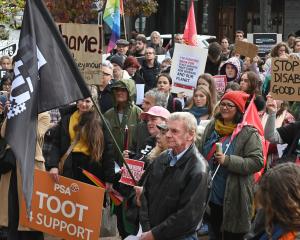
But Nima (29) also accepts his decision to speak out against the brutal tactics deployed by security forces may mean he is unable ever to return home.
The University of Otago music student — who came to Dunedin to study in 2015 — has asked for his identity to be protected, fearing reprisals against family members still living within the Islamic Republic.
He contacted the Otago Daily Times this week, after media reports emerged detailing the protests — sparked by a 300% hike in petrol prices — and violent reprisals by security forces.
Nima said it was the fourth significant wave of protests in 20 years aimed at Iran’s Supreme Leader, Ayatollah Ali Khamenei, but also the biggest.
Previous protests led by students and other ‘‘elites’’ had also been brutally suppressed, but this time poverty, fuelled by sanctions and economic mismanagement, was driving ordinary people into the streets, he said.
And, as unemployment and poverty spread and the protests increased, the security forces were discovering people now had nothing to lose, he said.
‘‘When people are hungry it doesn’t matter. They are already going to be dead, so they try to get what they want.’’
The protests began on November 15 and had spread quickly to more than 100 cities, towns and villages within two days, he said.
They were quelled by November 19, but Nima believed the discontent was continuing to simmer and would erupt again.
Amnesty International said at least 143 people have been killed, most of them unarmed protesters shot by security forces, although the true death toll was likely to be ‘‘significantly higher’’.
Nima told the ODT he believed the death toll would likely top 300, and 2000 more had been arrested during and after the protests.
Some had been seized from hospital beds while being treated for injuries, while the bodies of those killed by security forces had been removed from morgues, in an apparent attempt to hide the extent of the crackdown, he said.
An internet blackout had also been imposed across Iran, to prevent the spread of information.
The claims were supported by media reports and Amnesty International, although an Iranian official has claimed only ‘‘a few people’’ were killed.
Emeritus Professor Bill Harris, a Middle East scholar at the University of Otago, said a death toll of 300 or more was ‘‘what we could expect from such a regime’’.
The leadership was now under ‘‘serious challenge’’ from protesters, as US sanctions fuelled currency depreciation, inflation of 40% per annum and a ‘‘massive’’ economic contraction of almost 10% of GDP this year, he said.
‘‘Conditions for the majority of the population are devastating and desperate.’’
However, the regime also remained ‘‘deeply embedded’’ and wielded ‘‘an impressive apparatus of surveillance and repression’’, while regime loyalists and the ruling religious clique remained shielded.
Nima said video footage emerging from Iran showed some protesters ‘‘shouting out loud’’ for the return of the Shah — a reference to the monarchy overthrown by the Iranian Revolution of 1979, he said.
The last Shah’s son, Reza Pahlavi, still lives in exile in the United States, where he remains a vocal critic of the Iranian regime and heads a group preparing a transitional government, should it be needed.
Prof Harris said there was ‘‘nostalgia on the street’’ for the Shah, but it was ‘‘early days and a long way to go’’.
Nima said he hoped for change and was prepared to speak out — despite the potential consequences — because of the treatment imprisoned protesters would be enduring.
While some had been killed, others would be enduring beatings, rape and other forms of torture, even now, he believed.
‘‘Every minute I take breath here, I really think about the people who have been arrested and who are dead ... god knows what is going on in all those prisons.
‘‘All I want is to be their voice.’’
And, whatever happened, Nima said he expected the current lull was a calm before the storm and the protests would continue.
‘‘I don’t think it’s going to die. I believe this is a break, because people are starving.’’
Advertisement
Comments
So sad to hear. I was there 7yrs before the revolution when women wore mini skirts in the street. If it can happen there it can happen anywhere. Let's stick with democracy.
FWIW those 300% fuel price hikes bring their price of petrol to 15,000 Iranian Rial per litre. Here we pay about 188,000 Iranian Rial per litre. Their fuel is second cheapest in the world at 12 US cents per litre.













